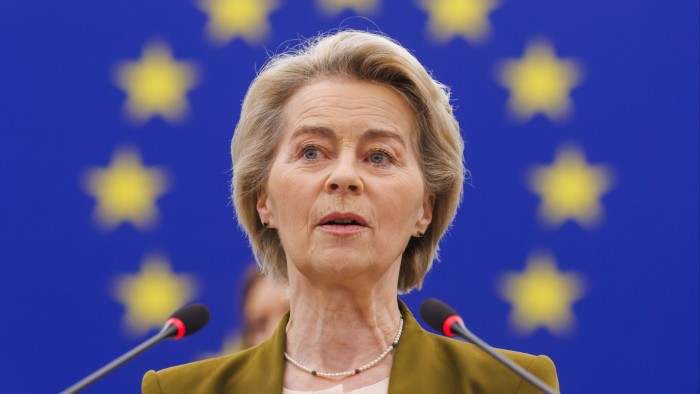
Unlock the Editor’s Digest totally free
Roula Khalaf, Editor of the FT, selects her favorite tales on this weekly e-newsletter.
The EU is contemplating redirecting €93bn in untapped pandemic restoration funds into its defence sector as a part of efforts to extend funding and navy spending after the Trump administration warned it might withdraw US safety assist from the continent.
European Fee president Ursula von der Leyen talked about the financing possibility at a gathering of the centre-right European Folks’s get together on Tuesday, in line with 4 individuals with data of the dialogue. The bloc’s extra financing wants for defence are estimated at about €500bn over the subsequent decade.
The EU might additionally repurpose regional improvement funds, von der Leyen mentioned and talked about “frequent European financing” as an alternative choice being explored, in line with one of many individuals conversant in the matter.
European officers have been discussing a plan in current months to arrange an inter-governmental financing automobile for defence, probably together with the UK and Norway, somewhat than the EU as an entire. This feature would circumvent the veto of impartial or Russia-friendly nations that aren’t in favour of utilizing joint debt for defence.
European borrowing is also extra palatable in capitals together with Berlin the place the prospect of one other spherical of joint EU debt is very contentious, notably with German federal elections happening on Sunday.
Within the UK, a gaggle of specialists have proposed a “rearmament financial institution” modelled on the European Financial institution for Reconstruction and Growth, the place collaborating governments would provide its capital — a prompt pot of €100bn — however pay solely 10 per cent up entrance. The financial institution would borrow the remainder within the capital markets, helped by a robust credit standing.
Within the absence of consensus on contemporary joint borrowing, EU capitals have pushed for the fee to faucet all unspent funds beneath its management.
The €93bn in leftover borrowing capability from its post-pandemic Restoration and Resilience Facility (RRF) represents untapped funds from a complete of €800bn in grants and loans agreed by the EU to be raised collectively to stimulate their economies after the pandemic. A number of capitals, together with Berlin, solely agreed to the post-pandemic fund offered that joint borrowing was a one-off.
Tapping the unused RRF financing would require adjustments to the fund’s guidelines, which might have to be backed by a majority of EU nations and the European parliament, a fee spokesperson mentioned.
The remaining funds, which might be disbursed as loans, might be used to spend money on analysis and improvement initiatives, in addition to for investments in so-called dual-use infrastructure similar to airports, which have each civilian and navy purposes.
Another choice the fee is exploring is to repurpose so-called cohesion funds which might be allotted to the least-developed EU areas.
“Primarily based on the brand new strategy, along with dual-use investments, cohesion coverage can now assist the defence sector, treating it to a big diploma as another trade,” in line with a notice from the fee’s regional funds division, seen by the Monetary Occasions.
“Investments in R&D immediately aiming at creating new applied sciences for the navy or . . . investments strengthening defence manufacturing capacities would now be eligible to contribute to regional improvement,” the notice learn.
EU nations may even be allowed to extend their nationwide defence budgets with out incurring sanctions beneath the bloc’s fiscal guidelines, von der Leyen introduced on the Munich Safety Convention over the weekend.
A spokesperson for von der Leyen didn’t instantly reply to a request for remark.




